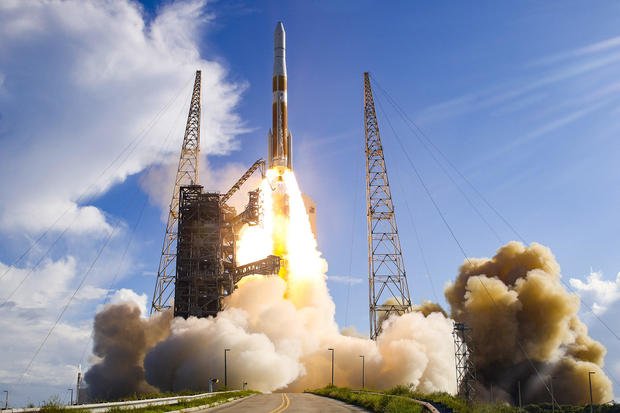Rocket launches GPS satellite into orbit for U.S. Air Force
The final medium-class Delta 4 rocket in the United Launch Alliance inventory roared to life and streaked away from Cape Canaveral early Thursday, propelling the second in a series of advanced GPS navigation satellites into orbit. The 207-foot-tall rocket's hydrogen-fueled RS-68A main engine ignited at 9:06 a.m. EDT, throttling up to full thrust with a rush of flaming exhaust.
An instant later, two solid-propellant strap-on boosters fired, and the Delta 4 climbed smoothly away from pad 37 at the Cape Canaveral Air Force Station in Florida. Arcing away to the northeast over the Atlantic Ocean, the rocket quickly accelerated and faded from view in the glare of the morning sun as it powered its way out of the thick lower atmosphere.
The strap-on boosters burned out and fell away about one minute and 40 seconds after liftoff, followed two-and-a-half minutes later by engine shutdown and first-stage separation. The hydrogen-burning RL10B-2 second-stage engine then fired up to continue the climb to orbit.
Two second-stage engine firings were required before the planned release of the GPS 3 satellite, nicknamed Magellan after the famed explorer.
"This one is special, Magellan, a new generation of GPS satellites, more powerful than those previously launched, offering improved accuracy, enhanced anti-jamming and a more robust design that will extend the spacecraft's life," said Colonel Thomas Ste. Marie, vice commander of the 45th Space Wing.
"It will serve U.S. and allied warfighters across the globe while also serving countless civil and commercial applications," he added.
For space historians, the launch marked the beginning of the end for the long-running Delta program.
Rocket-builder United Launch Alliance, a partnership between Boeing, builder of the Delta family of rockets, and Lockheed Martin, builder of the Atlas 5, is phasing out the heritage rockets in favor of a new booster -- the Vulcan -- expected to debut in 2021.
Only five heavy-lift Delta 4s remained on the books after Thursday's flight of the last single-core Delta 4 medium.
"As we seek to modernize GPS, we bid farewell and thank you to a launch vehicle with an excellent track record in the Delta 4," said Lieutenant General John F. Thompson, Space and Missile Systems Center commander and Air Force program executive officer for space.
Overall, the launching marked the 384th flight of a Delta rocket since 1960, the 135th since ULA was founded in 2002, the 40th launch of a Delta 4 and the 15th launch of the medium variant. All of the ULA flights have been successful.
The $200 million GPS 3 satellite is the second of 10 being built for the Air Force by Lockheed Martin. The company holds a second contract, valued at up to $7.2 billion, for up to 22 additional GPS 3 "Follow On" satellites providing more accurate, more jam-proof location, timing and velocity data to all branches of the military. The company built 18 of the 31 satellites in the current GPS constellation.
GPS satellites work by continuously transmitting ultra-precise timing signals from on-board atomic clocks along with precise position and velocity data. With at least two dozen satellites operating in six orbital planes, at least four "navsats" are always above the horizon for any user at any point on or above the Earth's surface.
By analyzing the slight differences between the arrival of the incoming signals, receivers can calculate a user's location, in three dimensions, to within about one-and-a-half feet on average and even better in some cases.
The jam-resistant GPS 3 satellites provide four civilian data streams that are used by devices ranging from smartphones to automobiles, commercial aircraft and virtually all sectors of the transportation industry. Multiple data streams enable receivers in aircraft to compensate for atmospheric effects that might otherwise degrade accuracy.
The new satellites also feature encrypted channels using sophisticated anti-jamming technology intended to keep the satellites operational under electronic attack. Military signals use so-called M-code processing, "a stronger and encrypted, military-specific GPS signal which can help users operate in jamming environments," according to the Government Accountability Office.
"GPS is a worldwide utility that affects the day-to-day activities of civilians and of military users around the world," said Lieutenant Colonel Margaret Sullivan, the Air Force GPS 3 program manager. "We're committed to maintaining GPS as the gold standard of positioning, navigation and timing for all other systems to be measured against."






